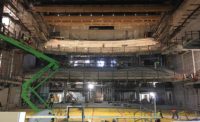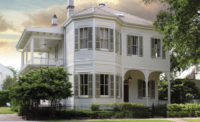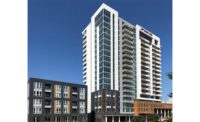“When I graduated from Virginia Tech, I got a job as an insulation salesperson and my company decided to pursue EIFS as part of their business model. I immediately fell in love with the system and decided to pursue it as a full-time career,” says Michael B. Chaney, president of James River Exteriors, telling W&C how he got involved in the trades specifically as an exterior cladding contractor.
The company, located in Richmond, Va., specializes in the design and installation of exterior wall claddings. With 23 years in business and currently approximately 50 employees, the company has membership with EIMA, AWCI, ABC, AGC, NAHB and the Home Builders Association of Richmond.
“We are an exterior cladding company, we can pretty much install any exterior cladding (other than glass) that you can think of,” Chaney says. “I think our flexibility and our niche is being able to install so many different products and the combination of numerous products. That makes us attractive in the eyes of building owners and general contractors because it’s single source responsibility and less involvement of multiple trades.”
Stay Focused
With nearly 25 years in the business, James River Exteriors has seen its share of the good times and the bad. Chaney says that like other businesses, the company has its share of ebbs and flows with the overall growth of the economy. James River Exteriors has grown steadily as a business since its inception (explosive growth during the 2000s) but now Chaney says the company is experiencing a more manageable incremental growth.
“We did experience the downturn, although because we are a finish trade we weren’t impacted as much in 2008 as we were in subsequent years,” says Chaney. “I think as our service offerings have increased so has our revenue but not by leaps and bounds like it did from 2002 to 2006.
He says currently that business is better but not spectacular. The downturn forced some competitors out of the marketplace, he says, but there isn’t the bulk of work available like it was in the previous decade.
“I think you are starting to see some reinvestment by companies that have been on the sideline for a number of years and as the economy continues to recover I think you will see more of that.”
Jobs Well Done
Recently, James River Exteriors worked on a 400-plus room dormitory for the rapidly growing Christopher Newport University, in Newport News, Va. The building was located right beside campus and was privately funded by the university’s real estate foundation.
W.M. Jordan Company Inc. served as the general contractor and Glave & Holmes Architecture served as the architect of record. Originally, James River Exteriors was contracted to install a synthetic (pre-finished and foam backed) pre-cast veneer cladding for the cornice and rake details, hard-coat stucco system at the gables, and the fiber cement siding at the roof wells.
“This was going to be the company’s first project with the synthetic pre-cast veneer material but we knew with our background in EIFS, masonry, and exterior trim we could make this a great project for all involved.”
“Since we were only contracted to install the synthetic pre-cast, our conversations with the manufacturer and distributor focused solely on installation,” Chaney reports. “Well, about two weeks before we were going to send our guys down to the manufacturer for training we received a phone call from our customer asking for our help because they were not getting a great feeling about the synthetic pre-cast manufacturer’s ability to produce the material needed within their schedule.”
Chaney had an immediate solution: EIFS. The company knew it could match the architect’s design intent and save its customer money while delivering a strong finish product. James Rivers Exterior’s only concern was matching the finish texture and color.
“We scrambled to build a mock-up and contacted Master Wall,” says Chaney. The EIFS manufacturer provided the necessary details and suggested the subcontractor use the Travertine finish.
“Looking back, the mock-up panel and approval process was the most stressful part of this project,” he says. “Once we mobilized and started everything pretty much went smoothly.”
The entire design was based on mimicking a pre-cast finish above the fourth floor that wouldn’t add the need for any additional structural supports since this building was wood framed. Once the finish color was chosen, Chaney says it was easy to satisfy the other stressed elements such as:
- Proper joint locations that would mimic the design of real pre-cast.
- Historically proper pre-cast details.
- Compound miter at all gables where eave terminates into the water-table and rake.
All of these elements were accomplished because of the flexibility of EIFS with the EPS foam. Ultimately, Master Wall’s Rollershield Drainage EIF system with the Travertine finish was chosen.
What Lies Ahead
So far, 2015 is still looking better for the subcontractor. Chaney says the current construction climate seems to be trending upward and he hopes that the company will follow that path, but there are also numerous challenges that the company faces every day. The aging workforce, regulatory changes, the lack of business operation credit available, and the use of technology in the industry are just some of the challenges that all wall and ceiling contractors face, he says.
“All of these things can be either opportunities or threats depending on how you attack them and your overall business plan.”
For Chaney, his personal long-term goals are to build a successful thriving business that provides for his family and can be a lasting legacy to leave. His sons are in the business and they are now having kids themselves.
“It would be an awesome accomplishment to see them carry on the business and possibly their children after them,” he says.







Report Abusive Comment